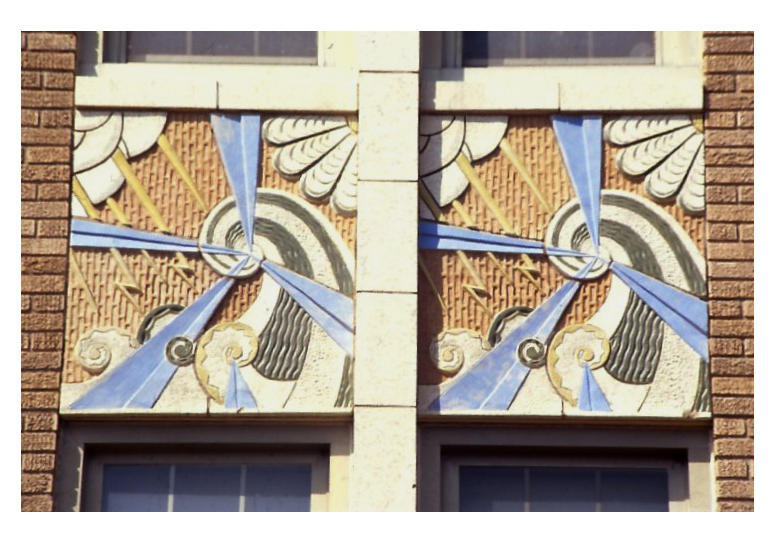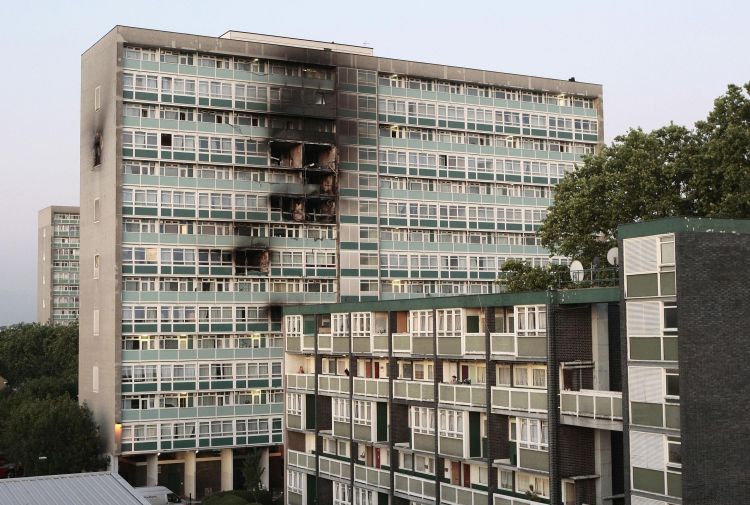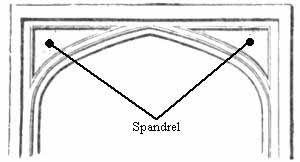Spandrel
In traditional building, the term 'spandrel' refers to the roughly triangular space or surface that is found between a curved figure and a rectangular boundary. It is thought to derive from from the Old French word 'spandre', meaning to spread.
Such spandrels can be found in a number of situations:
- The space between the curve of an arch and a rectilinear moulding.
- The space bounded by adjacent arches in an arcade and the horizontal moulding above.
- The space, where arches adjoin, between their crowns and springing lines. This is called a 'spandrel wall' if it is filled in.
- The space under a flight of stairs.
More recently, the term 'spandrel panel' has been used to refer to prefabricated triangular panels used in roof construction to separate spaces under the roof, or to complete the gable end of a roof. These panels can be installed quickly by crane, and mean that roofing contractors can complete wall elements under the roof rather than having to get brick or block layers to return to site.

|
| Carptrash at the English language Wikipedia [GFDL (http://www.gnu.org/copyleft/fdl.html) or CC-BY-SA-3.0 (http://creativecommons.org/licenses/by-sa/3.0/)], from Wikimedia Commons |
The term spandrel panel may also be used to refer to cladding panels that fill the space above the head of a window on one floor and below the cill of the window on the next floor on high-rise buildings. These panels conceal the floor structure. If they are made from opaque or translucent glass, this may be referred to as spandrel glass.
Problems with spandrel panels were linked to the Lakanal House fire in 2009, and in October 2018, following the Grenfell Tower fire, the government published advice that building owners should test the combustibility of spandrel, window and infill panels if there is no documented evidence of their fire resistance and to remove them if they are considered unsafe.
It suggests that; "Spandrel panels can be provided for both aesthetic and functional purposes. Like the rest of the external wall, the panels are generally required to meet acoustic, thermal, moisture, and fire performance requirements. Such panels are not normally load bearing but are often designed to account for wind loading... The design and materials of panels varies between buildings; some are made of singular components such as cement particle board, other panels are composite products comprising outer facing materials bonded to an inner core."
The advice states; "Where the panel product type can be confirmed building owners should check the fire performance with the manufacturer by requesting test certification. Where there is no information about the panel or there is uncertainty, it will be necessary to investigate the panel composition by sample testing."

|
| Lakanal House |
PAS 9980:2022, Fire risk appraisal of external wall construction and cladding of existing blocks of flats – Code of practice, published by BSI Standards Limited in 2022, defines a spandrel panel as an: ‘infill panel that is located between the sill of a window and the head of the window below, or that spans the floor slab area in a curtain wall system… A spandrel panel commonly spans a compartment floor boundary and, therefore, is significant in terms of the scope for the fire to bypass fire barriers between floors.’
NB The term spandrel beam refers to an exterior beam that extends from one column to another, carrying an exterior wall load.
[edit] Related articles on Designing Buildings
Featured articles and news
The UK's Modern Industrial Strategy: A 10 year plan
Previous consultation criticism, current key elements and general support with some persisting reservations.
Building Safety Regulator reforms
New roles, new staff and a new fast track service pave the way for a single construction regulator.
Architectural Technologist CPDs and Communications
CIAT CPD… and how you can do it!
Cooling centres and cool spaces
Managing extreme heat in cities by directing the public to places for heat stress relief and water sources.
Winter gardens: A brief history and warm variations
Extending the season with glass in different forms and terms.
Restoring Great Yarmouth's Winter Gardens
Transforming one of the least sustainable constructions imaginable.
Construction Skills Mission Board launch sector drive
Newly formed government and industry collaboration set strategy for recruiting an additional 100,000 construction workers a year.
New Architects Code comes into effect in September 2025
ARB Architects Code of Conduct and Practice available with ongoing consultation regarding guidance.
Welsh Skills Body (Medr) launches ambitious plan
The new skills body brings together funding and regulation of tertiary education and research for the devolved nation.
Paul Gandy FCIOB announced as next CIOB President
Former Tilbury Douglas CEO takes helm.
UK Infrastructure: A 10 Year Strategy. In brief with reactions
With the National Infrastructure and Service Transformation Authority (NISTA).
Ebenezer Howard: inventor of the garden city. Book review.
The Grenfell Tower fire, eight years on
A time to pause and reflect as Dubai tower block fire reported just before anniversary.
Airtightness Topic Guide BSRIA TG 27/2025
Explaining the basics of airtightness, what it is, why it's important, when it's required and how it's carried out.
Construction contract awards hit lowest point of 2025
Plummeting for second consecutive month, intensifying concerns for housing and infrastructure goals.
Understanding Mental Health in the Built Environment 2025
Examining the state of mental health in construction, shedding light on levels of stress, anxiety and depression.






















